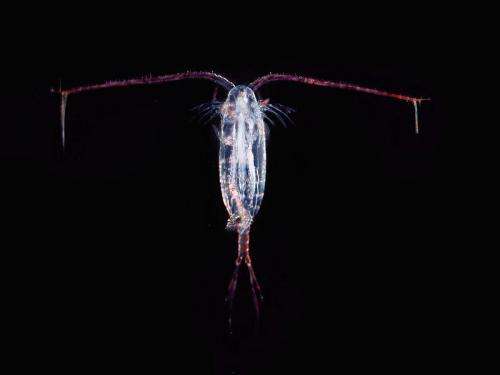January 28, 2014 report
Research shows copepods use pheromones to find mates

(Phys.org) —Copepods are tiny crustaceans, only millimeters long. Distributed sparsely in sea and fresh water, hundreds of body lengths may separate them. Oceanographer Laurent Seuront and biological physicist H. Eugene Stanley wanted to know how these small creatures find mates, as it would be unlikely for them to bump into each other accidently. In a study published in the Proceedings of the National Academy of Sciences, they determined that copepods change their movement patterns in response to pheromones produced by the opposite sex.
One cubic meter of water may contain only a few copepods. As distances between individuals are very great, they cannot wait for chance encounters and must actively pursue potential mates in order for their species to survive. Because the strategy for locating mates must work over long distances, relative to the animals' size, hydromechanical signals would not be effective, as such signals decay quickly. Therefore, it is likely that copepods use pheromones to find each other.
Biologists already know that female copepods leave chemical trails, which males follow. However, previous experiments examining male trail-following behavior studied copepods in still water, in a laboratory environment. Copepods often live in turbulent environments, at the ocean's surface and in estuaries, and Seuront and Stanley wanted to see how turbulence would affect the crustaceans' responses to chemical signals.
The researchers studied two copepod species found in the northern hemisphere: Temora longicornis, which lives in coastal waters, and Eurytemora affinis, which lives in estuaries. They placed male and females of both species in coastal or estuarial water that simulated their natural environments. Before placing the subjects in the water, Seuront and Stanley conditioned the water by placing various concentrations of copepods of the opposite sex in it and allowing them to remain there for 24 hours.
Seuront and Stanley found that conditioning the water affected how the subjects moved. As the concentration of opposite sex copepods used to condition the water increased, movements became less random.
Eventually, when the density was high enough, subjects began displaying movements associated with intense search strategies that depend on focusing on cues. These movements suggested that the copepods were reacting to pheromones released in the water during conditioning.
Females and non-virgin males of both species displayed this change in movement pattern. However, virgin T. longicornis and E. affinis males did not show any response to female-conditioned water. This suggests that females have an innate response to male pheromones, while the male response to female pheromones is learned. The researchers think that as males gain mating experience, they learn how the pheromone field created by females can help them locate mates.
More information: Anomalous diffusion and multifractality enhance mating encounters in the ocean, Laurent Seuront, PNAS, DOI: 10.1073/pnas.1322363111
Abstract
For millimeter-scale aquatic crustaceans such as copepods, ensuring reproductive success is a challenge as potential mates are often separated by hundreds of body lengths in a 3D environment. At the evolutionary scale, this led to the development of remote sensing abilities and behavioral strategies to locate, to track, and to capture a mate. Chemoreception plays a crucial role in increasing mate encounter rates through pheromone clouds and pheromone trails that can be followed over many body lengths. Empirical evidence of trail following behavior is, however, limited to laboratory experiments conducted in still water. An important open question concerns what happens in the turbulent waters of the surface ocean. We propose that copepods experience, and hence react to, a bulk-phase water pheromone concentration. Here we investigate the mating behavior of two key copepod species, Temora longicornis and Eurytemora affinis, to assess the role of background pheromone concentration and the relative roles played by males and females in mating encounters. We find that both males and females react to background pheromone concentration and exhibit both innate and acquired components in their mating strategies. The emerging swimming behaviors have stochastic properties that depend on pheromone concentration, sex, and species, are related to the level of reproductive experience of the individual tested, and significantly diverge from both the Lévy and Brownian models identified in predators searching for low- and high-density prey. Our results are consistent with an adaptation to increase mate encounter rates and hence to optimize reproductive fitness and success.
Journal information: Proceedings of the National Academy of Sciences
© 2014 Phys.org




















